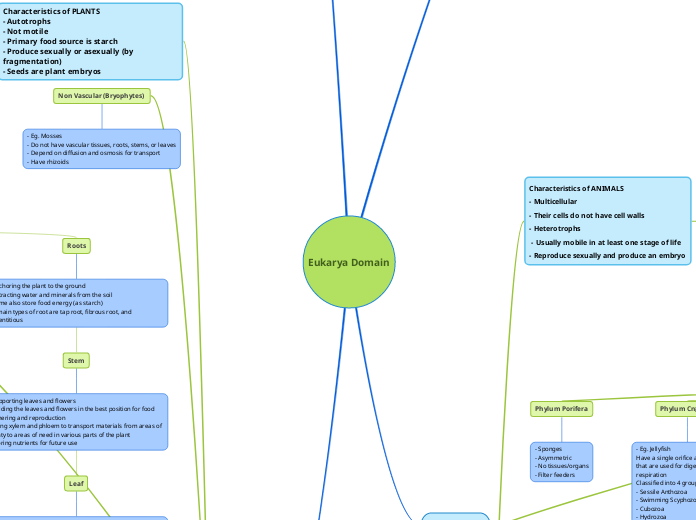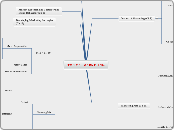Eukarya Domain
Plants
Vascular
Roots
- anchoring the plant to the ground
- extracting water and minerals from the soil
- some also store food energy (as starch)
- 3 main types of root are tap root, fibrous root, and adventitious
Stem
- supporting leaves and flowers
- holding the leaves and flowers in the best position for food gathering and reproduction
- using xylem and phloem to transport materials from areas of plenty to areas of need in various parts of the plant
- storing nutrients for future use
Leaf
- maximizing surface area for photosynthesis
- controlling the intake and release of gases (opening called “stoma” which are surrounded by 2 guard cells)
Stomata on Leaf Epidermis 100x
- Classified by seed or seedless plants
- 3 main structures: roots, stem, leaf
- 2 vascular tissue are xylem (carry water and minerals) and phloem (carry glucose)
Fern Leaflet (Seedless plant) 100X
Elodea W.M (Seed Bearing) 400X
2 types of seed bearing plants:
Angiosperms and Gymnosperms
Angiosperm (Flowering)
Angiosperms are produce protected seeds
using flowers as are their sexual
reproductive organs
Eg Tulips
- pollen is spread from the anther to the stigma of another plant (cross pollination) or the same plant (self pollination) by bees, insects, wind, etc.-
a pollen tube grows down the style into the ovary
- a sperm travels down the tube to fertilize one egg resulting in the development of a seed
Dicot
Two cotyledon (2 Seed Leaves)
Leaves of 4 or 5 petals
Network veins
Vascular bundles in rings
Dicot stem 100x
Dicot root 100x
Dicot leaf 400x
Monocot
One cotyledon (1 Seed Leaf)
Leaves of 3 petals
Parallel veins
Scattered vascular bundles
Monocot Stem 40x
Monocot root 100x
Monocot leaf 400x
Gymnosperm (Cone bearing)
Gymnosperms are plants that produce
naked seeds (mostly cone bearing plants)
using their sexual reproductive organs.
Eg. Pine trees
Pollination
- The pollen from the male cones are carried by the wind to the female cones to make seeds in a process
- The seeds are protected by a structure like a maple key and fall to the ground to germinate and grow into new trees.
Pollen 100x
Non Vascular (Bryophytes)
- Eg. Mosses
- Do not have vascular tissues, roots, stems, or leaves
- Depend on diffusion and osmosis for transport
- Have rhizoids
Characteristics of PLANTS
- Autotrophs
- Not motile
- Primary food source is starch
- Produce sexually or asexually (by fragmentation)
- Seeds are plant embryos
Fungi
5 Phyla of Fungi Reproduction
Club Fungi
Basidiomycota– have short lived fruiting bodies
E.g. mushrooms in the grass
Coprinus 100x
Sac Fungi
Ascomycota – largest group, develop finger-like sacs,
include yeasts
Zygospores
Zygomycota– usually multicellular, terrestrial
Eg. rhizopus (bread mould)
Rhizopus Sporangia 40x
Rhizopus Mycelium 100x
Chytrids
Chytridiomycota – mostly unicellular , aquatic, spores have flagella
E.g. Synchytrium endobioticum (potato wart)
Fungi Imperfecti
Deuteromycota - diverse but no sexual structures
E.g. Trichophyton rubrum (causes Athlete’s foot)
Nutrients
Parasitic
Predatory
Mutualistic
Saprobial
Characteristics of FUNGI
- Unicellular or multicellular
- Heterotrophs
- Have chitin cell walls
- Reproduce sexually or asexually
- Classified by reproduction
Structure
Hyphae: thread-like structure that makes up the base
Mycelium: Complex net like mass made of branching hyphae
Fruiting body: Spores producing reproductive structure
Hyphae of Mushroom 100x
Cap of Mushroom 400x
Spores/Gills of Mushroom 400x
Animals
Phylums of Animalia
Phylum Chordata
- Eg. Humans
- All chordates have had a notochord
in one stage in their life
- are deuterostomes
- are bilaterally symmetric
- have a fluid-filled body cavity
Subphylum Vertebrata
- Chordates with the notochord
replaced by a vertebral
column during development
Classes of Vertebrata
Class Mammalia
- Eg. Dogs
- Have hair
- Specialized Teeth
- Endothermic (warm-blooded)
- Have mammary Glands
- Have placenta (most)
- Diaphragm
- Give birth to live young except
monotremes and marsupials
Class Aves
- Eg. Falcons
- Have backbones
- Have feathers
- Endothermic
- Hollow bones
Class Reptilia
- Eg. Snakes
- First class of organisms to
adapt to life on land
- Cannot regulate own body
temperature
- Powerful jaw
Class Amphibia
- Eg. Frogs
- Live part of their lives in the
water and part of their lives
on the land
- 4 legged
Class Chondrichthyes
- Eg. Sharks
- Flexible skeleton made
of cartilage instead of bone
- One or two dorsal fins
Class Osteichthyes
- Eg. Eels
- Jawed fish
- Specific organs for respiration,
excretion and blood circulation.
- Have a swim bladder (gas filled
sac)
Class Agnatha
- Eg. Lampreys
- Jawless fish
- Earliest vertebrates
- Most agnathans have
a skeleton made of cartilage
- Fertilization of eggs takes
place outside the body.
Subphylum Tunicata
- Sea squirts, larvaceans both of
which are soft-bodied filter-feeders
- Sessile
- Salps float in water and feeds on
plankton
Subphylum Cephalochordata
- Lancets (Amphioxus)
- Small, "vaguely fish-shaped"
animals that lack brains,
clearly defined heads and
specialized sense organs
Phylum Arthropoda
- Eg. Spiders
- insects and crustaceans
- Invertebrates with exoskeletons
(made of chitin)
- Hemolymph
- All terrestrial species use internal
fertilization
- Aquatic can use internal or external
Phylum Mollusca
- Eg. Squid
- Body cavity is a hemocoel
(open circulatory system)
- Most molluscs have muscular
mouths with radulae
- Most perform external fertilization
- Hermaphrodite molluscs use
internal fertilization
Phylum Annelida
- Eg. Leeches
- Segmented worms
- Closed circulatory system
(blood is contained in tubes)
- Eat microscopic critters in the soil
- Sexually and asexually
Phylum Nematoda
- Eg. Tapeworms
- Have true digestive system
open at both ends (mouth and anus)
- Round body
- Parasites
- Sexually and asexually
Phylum Platyhelminthes
- Eg. Flatworms
- Invertebrates
- Bilateral symmetry
- Flattened body
- Can be scavengers or parasites
- Sexually and asexually
Planarian W.M 100x
Planarian C.S 400x
Phylum Echinodermata
- Eg. Starfish, sea urchins
- Have radial symmetry,
- Most are able to reproduce
asexually
and regenerate tissue, organs,
and limbs.
Phylum Cnidaria
- Eg. Jellyfish
Have a single orifice and body cavity
that are used for digestion and
respiration
Classified into 4 groups
- Sessile Anthozoa
- Swimming Scyphozoa
- Cubozoa
- Hydrozoa
Hydra 40x
Phylum Porifera
- Sponges
- Asymmetric
- No tissues/organs
- Filter feeders
Characteristics of ANIMALS
- Multicellular
- Their cells do not have cell walls
- Heterotrophs
- Usually mobile in at least one stage of life
- Reproduce sexually and produce an embryo
Classification
- Presence of backbone
Vertebrates have a backbone and invertebrates do not
have a backbone.
- Levels of organization
Varying levels of structure and complexity in systems (circulatory, respiratory, etc.)- Symmetry
- Body layers
All animals except sponges have 3 body layers. Ectoderm (outer layer) mesoderm (middle layer) , and endoderm (inner layer)
- Body cavity
Coelom is a fluid filled body cavity that contains organ systems
Coelomates have a coelom and acoelomates do not have a coelom
- Symmetry
Animals are either non symmetrical, have radial symmetry (body parts repeat around one axis point) or have bilateral symmetry (body has a mirror image, two equal halves) Segmentation
Division of body into repetitive sections or segments
- Movement
Motile = capable of locomotion Sessile = stationary
- Reproduction
Most animals reproduce sexually. Gametes formed through meiosis. Asexual reproduction methods are fragmentation and budding.
Protists
Protists are grouped together in this kingdom because they are not a fungus, plant or animal. (miscellaneous group) Protists move by using pseudopods (false feet), ciliates (hair), flagella (tail).
Fungus Like
Phylum Acrasiomycota
Cellular slime mould
- Filamentous
- Some parasitic (extend threads into
host tissues and absorb nutrients)
Phylum Oomycota
Water Mould
- Pseudoplasmodium
forms when food is scarce
- Ingests bacteria or yeast
Plant like
Unicellular
Phylum Euglenozoa
Euglena 400x
- Autotrophs in sunlight
- Heterotrophs in the dark
- Has an eyespot to detect light
Multicellular
Algae
Spirogyra 40x
- Found in freshwater
environments
- Spiral chloroplasts
Animal like
Phylum Cercozoa
Amoeba Proteus 400x
- Uses pseudopods to move
- Lives in decaying vegetation
in fresh or saltwater or in animals
- Eats bacteria, metazoa, protozoa,
plant cells
Phylum Ciliophora
Paramecium 400x
- Uses ciliates to move
- Lives in aquatic environments
- Feed on microorganisms like
yeast, bacteria, and algae









